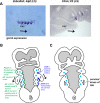Developmental and evolutionary origins of the pharyngeal apparatus
- PMID: 23020903
- PMCID: PMC3564725
- DOI: 10.1186/2041-9139-3-24
Developmental and evolutionary origins of the pharyngeal apparatus
Abstract
The vertebrate pharyngeal apparatus, serving the dual functions of feeding and respiration, has its embryonic origin in a series of bulges found on the lateral surface of the head, the pharyngeal arches. Developmental studies have been able to discern how these structures are constructed and this has opened the way for an analysis of how the pharyngeal apparatus was assembled and modified during evolution. For many years, the role of the neural crest in organizing pharyngeal development was emphasized and, as this was believed to be a uniquely vertebrate cell type, it was suggested that the development of the pharyngeal apparatus of vertebrates was distinct from that of other chordates. However, it has now been established that a key event in vertebrate pharyngeal development is the outpocketing of the endoderm to form the pharyngeal pouches. Significantly, outpocketing of the pharyngeal endoderm is a basal deuterostome character and the regulatory network that mediates this process is conserved. Thus, the framework around which the vertebrate pharyngeal apparatus is built is ancient. The pharyngeal arches of vertebrates are, however, more complex and this can be ascribed to these structures being populated by neural crest cells, which form the skeletal support of the pharynx, and mesoderm, which will give rise to the musculature and the arch arteries. Within the vertebrates, as development progresses beyond the phylotypic stage, the pharyngeal apparatus has also been extensively remodelled and this has seemingly involved radical alterations to the developmental programme. Recent studies, however, have shown that these alterations were not as dramatic as previously believed. Thus, while the evolution of amniotes was believed to have involved the loss of gills and their covering, the operculum, it is now apparent that neither of these structures was completely lost. Rather, the gills were transformed into the parathyroid glands and the operculum still exists as an embryonic entity and is still required for the internalization of the posterior pharyngeal arches. Thus, the key steps in our phylogenetic history are laid out during the development of our pharyngeal apparatus.
Figures




References
-
- Schoenwolf GC, Bleyl SB, Brauer PR, Francis-West PH. Larsen's Human Embryology. Philadelphia: Churchill Livingstone; 2009.
-
- Hoerstadius S, Sellman S. Experimentelle Untersuchungen ueber die Determination des Knorpeligen Kopfskelettes bei Urodelen. Nova Acta Regiae Soc Sci Ups Ser IV. 1946;13:1–170.
-
- Wagner G. Die Bedeutung der Neuralleiste fur die Kopfgestaltung der Amphibienlarven. Rev Suisse Zool. 1949;56:519–620.
LinkOut - more resources
Full Text Sources

